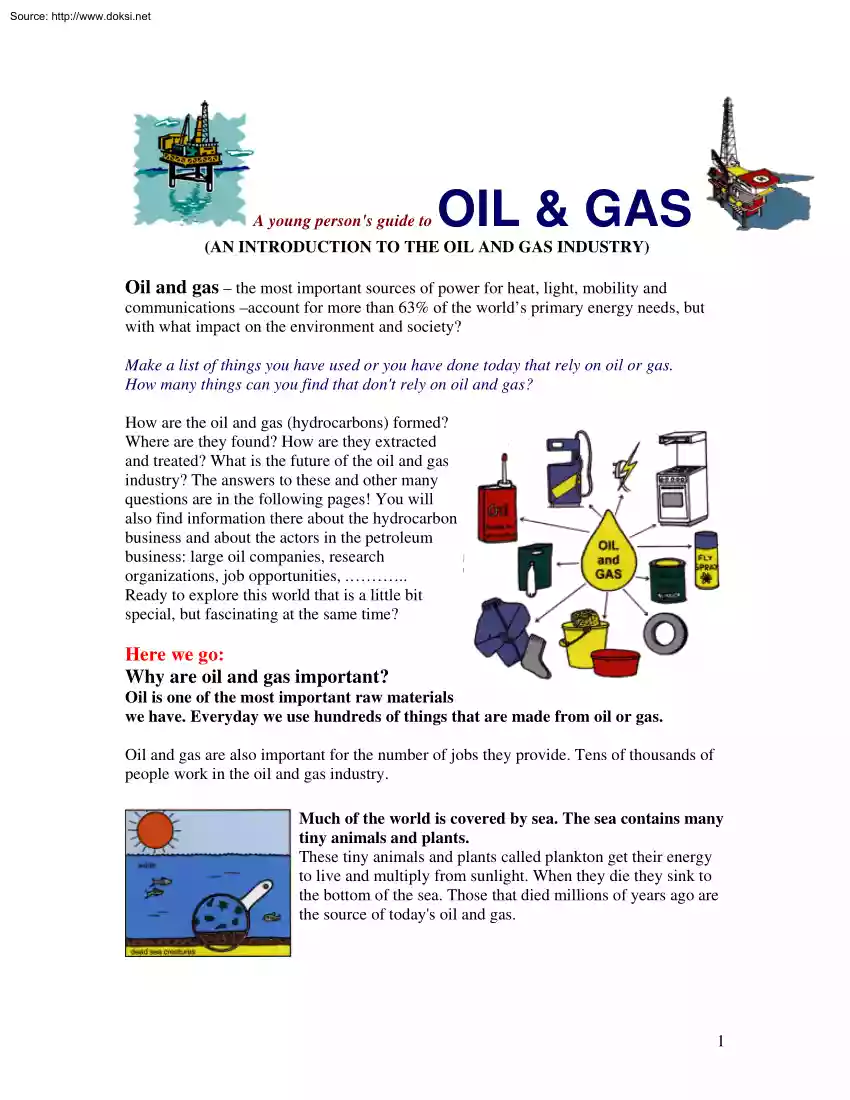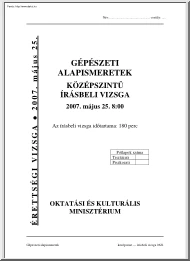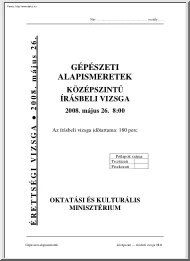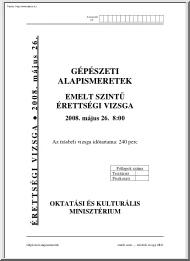Datasheet
Year, pagecount:2012, 5 page(s)
Language:English
Downloads:2
Uploaded:September 03, 2020
Size:764 KB
Institution:
-
Comments:
Attachment:-
Download in PDF:Please log in!
Comments
No comments yet. You can be the first!Most popular documents in this category
Content extract
Source: http://www.doksinet A young persons guide to OIL & GAS (AN INTRODUCTION TO THE OIL AND GAS INDUSTRY) Oil and gas – the most important sources of power for heat, light, mobility and communications –account for more than 63% of the world’s primary energy needs, but with what impact on the environment and society? Make a list of things you have used or you have done today that rely on oil or gas. How many things can you find that dont rely on oil and gas? How are the oil and gas (hydrocarbons) formed? Where are they found? How are they extracted and treated? What is the future of the oil and gas industry? The answers to these and other many questions are in the following pages! You will also find information there about the hydrocarbon business and about the actors in the petroleum business: large oil companies, research organizations, job opportunities, . Ready to explore this world that is a little bit special, but fascinating at the same time? Here we go: Why are
oil and gas important? Oil is one of the most important raw materials we have. Everyday we use hundreds of things that are made from oil or gas Oil and gas are also important for the number of jobs they provide. Tens of thousands of people work in the oil and gas industry. Much of the world is covered by sea. The sea contains many tiny animals and plants. These tiny animals and plants called plankton get their energy to live and multiply from sunlight. When they die they sink to the bottom of the sea. Those that died millions of years ago are the source of todays oil and gas. 1 Source: http://www.doksinet The dead sea creatures were buried by sand and mud at the bottom of the sea. It is thought that the suns energy was stored in the bodies of the dead creatures and plants. The dead bodies started to decay Over millions of years the dead animals and plants were buried deeper and deeper. The squashed creatures turned into oil and gas. The pressure and temperature deep underground
turned the chemicals from the decaying animals and plants into crude oil and gas. How do we get oil and gas out of the ground? Oil and gas can get trapped in pockets underground such as where the rocks are folded into an umbrella shape. Oil and gas can move through the porous rocks (rocks with gaps between the grains). The oil and gas move upwards from the source rock where they were formed. When they met a layer of cap rock (a rock with no spaces between the grains) the oil and gas are trapped. A well is drilled so that the crude oil and other liquids travel up the borehole. When it comes to the surface the crude oil has to be moved closer to where it is needed. Finding oil and gas trapped deep underground and drilling a well are very complicated and expensive. It costs millions of pound to drill a well and only a few are successful. The liquids found underground can be a complicated mixture of water, crude oil and gas. The crude oil and gas need to be separated before they can be
transported safely. Which rocks are porous and could make good reservoir rock? Plan an investigation to find out which rocks are most porous. Can you find out how the people who search for oil discover oil traps deep beneath the land and seabed? 2 Source: http://www.doksinet How are oil and gas transported? Oil and gas are often found far away or under the sea. They have to be transported to an oil refinery. This is often through a pipeline or in a tanker. The crude oil is often found in remote places such as deserts, jungle or the Arctic. Transport of the crude oil to the refinery is sometimes very complicated. The oil refinery turns crude oil into useful products and materials. These are transported all over the world. The products can travel through pipelines, by road, rail or by boats around the coast or along rivers and canals. How is crude oil turned into finished products? Crude oil is often a dark, sticky liquid that cannot be used without changing it. The first part of
refining crude oil is to heat it until it boils. The boiling liquid is separated into different liquids and gases in a distillation column. These liquids are used to make petrol, paraffin, diesel fuel etc. Crude oil is a mixture of different chemical called hydrocarbons. The boiling oil turns into a mixture of gases in the column. The gases flow up the column, which is hottest at the bottom and cooler at the top. The gases cool down as they go up the column until they condense (turn back into liquid again). The separated liquids and gases, after cleaning and further processing, are used to make many products. 3 Source: http://www.doksinet Liquids from refining oil still have to be changed to make them more useful. Sometimes its to make them clean enough to be used. Sometimes its to turn some of the unwanted liquids into things people want to buy. The heavier liquids are in less demand from customers so are turned into lighter products that are in demand. One of the processes is
called catalytic cracking. It breaks down some of the heavy liquids from the distillation column. The heavy liquids are changed into simple and more useful liquids and gases. Cracking is just one of many chemical changes in an oil refinery. Which of the products from oil refining are used in the largest quantities? What is the point of cracking heavy liquids into lighter liquids and gases? What things are made from oil and gas? In an oil refinery and in a chemical works, crude oil and gas are turned into hundreds of useful products. ─Cosmetics ─Clothing ─Medicines ─Sports equipment ─Automotive parts and many more. How do these products get to the customer? Thousands of people are employed to make sure all these useful products get to the millions of people in the world who want to buy them everyday. Many thousands of people are employed in oil and gas industry. Many of these work to get petrol and diesel fuel to where it is wanted - filling stations - for motorists, lorry
drivers, taxis and buses. Make a list of the jobs involved in finding and getting oil from under the ground to the petrol and diesel fuel at the filling station pumps. Dont forget to include exploration, drilling, refining, transporting, selling and all the supporting jobs. 4 Source: http://www.doksinet Opportunities for You In the Oil Industry Petroleum Careers: Want to be challenged? Want to work with the latest technology? Want to be involved with an industry that is critical to the world economy? If so, consider a career in the oil & gas industry. Industry professionals work with (and develop) cutting-edge technologies to respond to the challenges of producing oil and gas. New sources of oil and gas are often found beneath the ocean or in remote areas, and require sophisticated technology to recover these resources. The industry is trying to find alternative sources of energy therefore need to perform more and more research and development work. You have a bright future in
the oil industry as some of the young engineers in the industry say that their jobs are: Fascinating! Incredible! As amazing as space travel! I get a chance to be a part of the future! If you want to have a rewarding career where you ■ Travel the world ■ Meet cool people ■ Experience amazing adventures ■ Work with the latest technology ■ Make great money then come and join the oil & gas industry “SPE EDUCATION DAY” IS DEDICATED TOWARDS GIVING YOUNG STUDENTS LIKE YOU AN OPPORTUNITY TO KNOW ABOUT THE OIL AND GAS INDUSTRY. WE ENCOURAGE YOU TO JOIN THIS INDUSTRY” Source of information: http://www.world-petroleumorg/education/ip1/ip1html http://www.energy4meorg/careers/careershtm http://www.fotosearchcom/ http://www.speorg http://www.planete-energiescom/site/en/homepagehtml 5
oil and gas important? Oil is one of the most important raw materials we have. Everyday we use hundreds of things that are made from oil or gas Oil and gas are also important for the number of jobs they provide. Tens of thousands of people work in the oil and gas industry. Much of the world is covered by sea. The sea contains many tiny animals and plants. These tiny animals and plants called plankton get their energy to live and multiply from sunlight. When they die they sink to the bottom of the sea. Those that died millions of years ago are the source of todays oil and gas. 1 Source: http://www.doksinet The dead sea creatures were buried by sand and mud at the bottom of the sea. It is thought that the suns energy was stored in the bodies of the dead creatures and plants. The dead bodies started to decay Over millions of years the dead animals and plants were buried deeper and deeper. The squashed creatures turned into oil and gas. The pressure and temperature deep underground
turned the chemicals from the decaying animals and plants into crude oil and gas. How do we get oil and gas out of the ground? Oil and gas can get trapped in pockets underground such as where the rocks are folded into an umbrella shape. Oil and gas can move through the porous rocks (rocks with gaps between the grains). The oil and gas move upwards from the source rock where they were formed. When they met a layer of cap rock (a rock with no spaces between the grains) the oil and gas are trapped. A well is drilled so that the crude oil and other liquids travel up the borehole. When it comes to the surface the crude oil has to be moved closer to where it is needed. Finding oil and gas trapped deep underground and drilling a well are very complicated and expensive. It costs millions of pound to drill a well and only a few are successful. The liquids found underground can be a complicated mixture of water, crude oil and gas. The crude oil and gas need to be separated before they can be
transported safely. Which rocks are porous and could make good reservoir rock? Plan an investigation to find out which rocks are most porous. Can you find out how the people who search for oil discover oil traps deep beneath the land and seabed? 2 Source: http://www.doksinet How are oil and gas transported? Oil and gas are often found far away or under the sea. They have to be transported to an oil refinery. This is often through a pipeline or in a tanker. The crude oil is often found in remote places such as deserts, jungle or the Arctic. Transport of the crude oil to the refinery is sometimes very complicated. The oil refinery turns crude oil into useful products and materials. These are transported all over the world. The products can travel through pipelines, by road, rail or by boats around the coast or along rivers and canals. How is crude oil turned into finished products? Crude oil is often a dark, sticky liquid that cannot be used without changing it. The first part of
refining crude oil is to heat it until it boils. The boiling liquid is separated into different liquids and gases in a distillation column. These liquids are used to make petrol, paraffin, diesel fuel etc. Crude oil is a mixture of different chemical called hydrocarbons. The boiling oil turns into a mixture of gases in the column. The gases flow up the column, which is hottest at the bottom and cooler at the top. The gases cool down as they go up the column until they condense (turn back into liquid again). The separated liquids and gases, after cleaning and further processing, are used to make many products. 3 Source: http://www.doksinet Liquids from refining oil still have to be changed to make them more useful. Sometimes its to make them clean enough to be used. Sometimes its to turn some of the unwanted liquids into things people want to buy. The heavier liquids are in less demand from customers so are turned into lighter products that are in demand. One of the processes is
called catalytic cracking. It breaks down some of the heavy liquids from the distillation column. The heavy liquids are changed into simple and more useful liquids and gases. Cracking is just one of many chemical changes in an oil refinery. Which of the products from oil refining are used in the largest quantities? What is the point of cracking heavy liquids into lighter liquids and gases? What things are made from oil and gas? In an oil refinery and in a chemical works, crude oil and gas are turned into hundreds of useful products. ─Cosmetics ─Clothing ─Medicines ─Sports equipment ─Automotive parts and many more. How do these products get to the customer? Thousands of people are employed to make sure all these useful products get to the millions of people in the world who want to buy them everyday. Many thousands of people are employed in oil and gas industry. Many of these work to get petrol and diesel fuel to where it is wanted - filling stations - for motorists, lorry
drivers, taxis and buses. Make a list of the jobs involved in finding and getting oil from under the ground to the petrol and diesel fuel at the filling station pumps. Dont forget to include exploration, drilling, refining, transporting, selling and all the supporting jobs. 4 Source: http://www.doksinet Opportunities for You In the Oil Industry Petroleum Careers: Want to be challenged? Want to work with the latest technology? Want to be involved with an industry that is critical to the world economy? If so, consider a career in the oil & gas industry. Industry professionals work with (and develop) cutting-edge technologies to respond to the challenges of producing oil and gas. New sources of oil and gas are often found beneath the ocean or in remote areas, and require sophisticated technology to recover these resources. The industry is trying to find alternative sources of energy therefore need to perform more and more research and development work. You have a bright future in
the oil industry as some of the young engineers in the industry say that their jobs are: Fascinating! Incredible! As amazing as space travel! I get a chance to be a part of the future! If you want to have a rewarding career where you ■ Travel the world ■ Meet cool people ■ Experience amazing adventures ■ Work with the latest technology ■ Make great money then come and join the oil & gas industry “SPE EDUCATION DAY” IS DEDICATED TOWARDS GIVING YOUNG STUDENTS LIKE YOU AN OPPORTUNITY TO KNOW ABOUT THE OIL AND GAS INDUSTRY. WE ENCOURAGE YOU TO JOIN THIS INDUSTRY” Source of information: http://www.world-petroleumorg/education/ip1/ip1html http://www.energy4meorg/careers/careershtm http://www.fotosearchcom/ http://www.speorg http://www.planete-energiescom/site/en/homepagehtml 5





